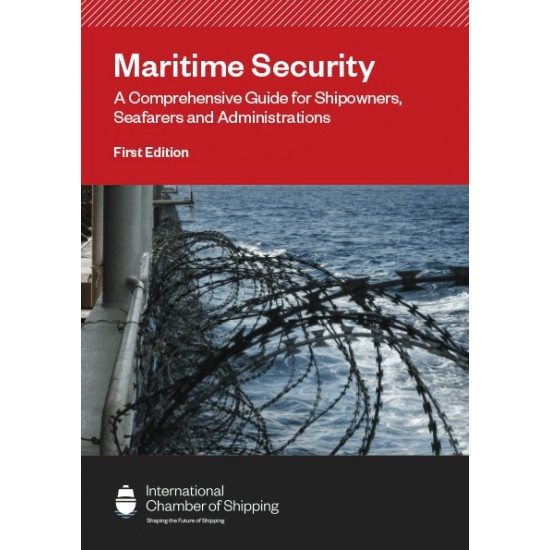- Home
-
Products
-
E-Navigation
-
Services
-
Resources & Information
- IMO Publication Carriage Requirements On Board Vessels
- U.S. Carriage Requirements for Nautical Charts & Publications on Board Ships
- List of Flag States Requiring Carriage Of Publications
- Rescue Net Information & Solutions
- Jane's Fighting Ships
- The Mariner's Blog
- Maritime Resource Directory
- Instructional Videos
- Downloads
- About
- Contact

Overview
Maritime security is an increasing concern for the shipping industry and security threats present real challenges to the entire global supply chain. In the years since SOLAS and the ISPS Code set out a dedicated statutory framework for the issue, a new security culture has emerged in the industry which has led to increasing understanding of the subject and best practices to mitigate particular threats. But the threats are always evolving and require constant vigilance
This book provides a comprehensive guide to maritime security. Drawing on two decades of experience in the industry, it sets out the security threats faced by the shipping industry today, the statutory requirements that ships, shipping companies and port facilities must meet, and provides guidance on how to conduct a thorough threat assessment for a voyage. A model ship security plan is also provided along with guidance on how to complete it in accordance with statutory requirements.
It will be particularly useful to ship and terminal operators, seafarers and administrations, but will provide a useful entry point to the subject for anyone with an interest in maintaining the security of global trade.
Content
Chapter 1 Introduction
1.1 What is Maritime Security?
1.2 SOLAS and the ISPS Code
1.3 Other Security Threats and Best Practice Guidance
Chapter 2 Maritime Security Threats
2.1 Introduction
2.2 Piracy and Armed Robbery
2.3 Terrorism
2.4 War and War-like Risks
2.5 Joint War Committee Listed Areas
2.6 Cyber Risk Management
2.7 Smuggling
2.8 Mixed Mass Migration
2.9 Stowaways
Chapter 3 Overview of Regulatory Requirements
3.1 SOLAS Chapter XI-2 and the ISPS Code
3.1.1 Construction and Carriage Requirements
3.2 Company Requirements
3.3 Shipboard Requirements and Responsibilities
3.4 Ship Vetting Inspections
3.5 Contracting State Requirements and Responsibilities
3.6 Port State Responsibilities during Ship/Port Interface
Chapter 4 The Ship Security Plan
4.1 The Ship Security Plan (SSP)
4.2 Ship Security Plan Content
4.3 Access to the Ship (and Security Levels)
4.4 Restricted Areas on the Ship
4.5 Handling of Cargo
4.6 Delivery of Ship’s Stores
4.7 Handling Baggage
4.8 Monitoring the Security of the Ship
4.9 Differing Security Levels
4.10 Activities Not Covered by the Code
4.11 Declaration of Security (DoS)
4.12 Audit and Review
4.13 Amendments to the Ship Security Plan
4.14 Inspections
4.15 Security Drills
4.16 Record Keeping
Chapter 5 Managing and Mitigating Security Threats
5.1 Introduction
5.2 Voluntary Reporting and Registration
5.3 Company Threat and Risk Assessment
5.4 Company Planning
5.5 Ship Master’s Planning
5.6 Ship Protection Measures and Vessel Hardening
5.7 Contingency Planning for Developing Security Incidents
5.8 Post Incident Reporting and Investigation
5.9 Humanitarian Considerations
Annexes
Annex A Pre-Arrival Security Clearances
Annex B Arrival in Port and Security/Shore Access for Seafarers
Annex C Useful Resources on Maritime Security
Annex D The Ship Security Assessment (SSA)
Annex E Model Ship Security Plan – Restricted Part
Annex F Model Ship Security Plan – Confidential Part
Annex G Vessel Hardening Plan
Annex H Additional Considerations for Passenger Ship Security
Introduction
1.1 What is Maritime Security?
Maritime security is a matter of increasing concern to the global shipping industry. While the security of ship, crew and cargo has always been of key importance, attention and understanding of the issue has grown in recent years following the development of a dedicated statutory framework under SOLAS. In addition, while the industry has always faced external security threats, the evolution of existing threats and the emergence of new ones poses even greater challenges. With the growth in threat and awareness has come an expansion of the security provisions applied by companies.
A new security culture has emerged in the industry, supported by extensive best practice guidance.
There are a wide range of security threats facing the shipping industry and while the most prevalent are piracy and armed robbery, the threats of terrorism, war and warlike activity can present significant risks. Similarly, illegal activities such as smuggling of drugs, people or weapons can compromise security and endanger a ship and its crew. The increasing connectedness of information and operational technologies in shipping presents another avenue through which security can also be prejudiced.
1.2 SOLAS and the ISPS Code
Maritime security is enforced through Chapter XI-2 of the SOLAS Convention and the International Ship and Port Facility Security (ISPS) Code, which entered into force on 1 January 2004. The Convention and Code enforce statutory requirements for ships and port facilities with respect to their own security and the interface between them. Obligations are placed on the shipowner, the port and their respective personnel, and are overseen by the flag State and shoreside designated authority, who also have a responsibility to ensure the security of the assets under their jurisdiction.
The key requirement of the regulation and Code is for the development of a ship specific security plan for every ship of 500 GT and over. Similarly, there is an obligation on port facilities to develop and implement a Port Facility Security Plan (PFSP). In each case these plans are approved by national Authorities and are subject to periodic audit and review. The Code also sets out carriage requirements for equipment to track and identify ships, including automatic identification system (AIS) and long range identification tracking (LRIT).
See Chapter 3 for more detail on the Convention and Code.
1.3 Other Security Threats and Best Practice Guidance
While the ISPS Code was specifically developed in response to the terrorist attacks of 11 September, 2001, it was not explicitly intended to solely cover the threat of terrorism. However, the overall construction and requirements of the regulations are principally directed towards that threat. As such, the rigidity of the requirements, particularly with respect to the authorisation of security plans, means that it does not easily extend to cover evolving or changeable threats and risks that can require a dynamic response. These include the many threats and risks that a ship may face on a single voyage through different points of maritime insecurity. In response, the shipping industry has developed extensive best practice guidance to meet these challenges on a real-time basis and supporting reporting and response architectures have, similarly, developed outside the ISPS framework, supported by States and international organisations.
1.4 Maritime Security Guide
The most significant development in this respect has been the evolution of the threat and risk assessment process for maritime security. These practices extend far beyond the scope of statutory requirements and are essential for minimising security risks and safeguarding ships in areas of maritime insecurity. They serve to demonstrate how industry self-regulation can provide the best and most dynamic means to ensure the security of the world fleet, building on the foundation of the ISPS Code.
How to Use This Guide
This guidance covers all aspects of maritime security and is for the use of Company Security Officers (CSOs), Masters and Ship Security Officers (SSOs). It also provides useful information for port personnel and administrations.
The document provides detailed guidance on the most prevalent security threats faced by the shipping industry and on the statutory requirements of SOLAS, the ISPS Code, the Ship Security Plan (SSP) and on managing and mitigating security threats. The Annexes provide useful checklists and resources for complying with statutory obligations and conducting threat and risk assessments. A model SSP and other resources are provided in the Annexes.
Details
Title: Maritime Security. A Comprehensive Guide for Shipowners, Seafarers and Administrations
Edition: First
Product Code: IT104229
Published Date: April 2021
Weight: 1.60 kg
Author: International Chamber of Shipping








